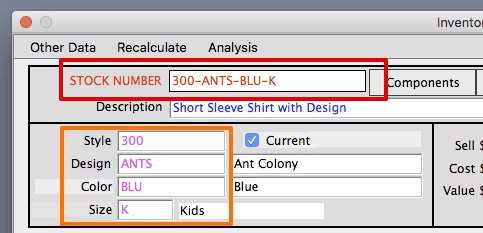
The Stock Number of a PERFECT FIT Product is made up of the STYLE, DESIGN, COLOR, and SIZE CATEGORY, all separated by dashes.
If one of the sub fields is not used the stock number ignores it.
We recommend you DO NOT use dashes in any of the sub fields, as that may confuse the user as which part of the stock number represents the color, etc.
Using a combination of number and letters can also make it easier to read.
Using non-standard characters ($%@#&* etc) may confuse the computer operating system or web pages if you ever use e-commerce.
We have noticed that some users refer to the Style Number as the full stock number. To make communication clearer please understand the difference between the Stock Number and the Style.
Advantages of Inventory Coding by letters:
easier to remember during data entry, during discussions, etc.
shorter training time for new employees
real info is contained in the stock number
Customer is less likely to make a mistake when ordering
More codes are available for shorter stock numbers
(eg, for a 2 char code, 26 x 26 = 676, vs 10 x 10 = 100)
Advantages of Coding by numbers:
Easier to type in during data entry.
Controlling sort orders easier.
(eg, start accessories with a 9 and they will always be at the end of the list)
Easier to set up classifications and sub variations in products
(eg: T-shirts with scoop neck are 80xx, and T-Shirts with V necks are 81xx, etc.
Allows for more detailed searching of the database
(eg, compare sales of scoop necks with V necks)
No reason why you can’t use both! Maybe use 3 or 4 numbers for the style, and 2-3 letters for the color code. We also try to keep the size range code to a single number or character. Shorter is usually better, especially for popular products.
Keep It Simple!
Revised by AG, 12-8-19
Copyright © AS Systems, All Rights Reserved | WordPress Development by WEBDOGS